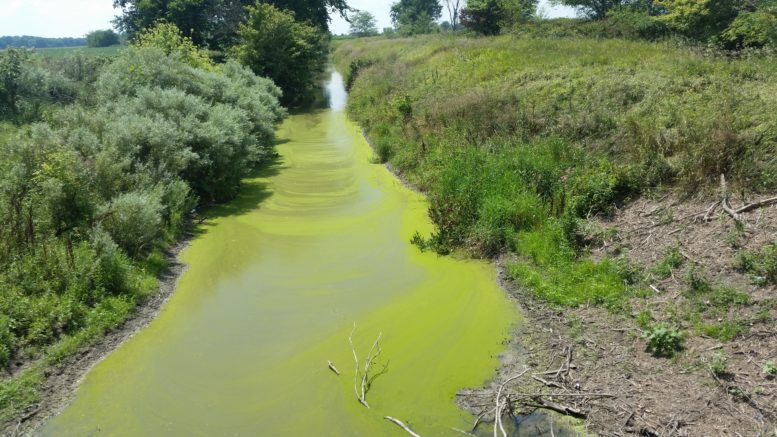By JAN LARSON McLAUGHLIN
BG Independent News
Beth Landers comes from a long line of farmers – so she knows they can be stubborn, independent and proud.
As the Portage River watershed coordinator with the Wood Soil and Water Conservation District, Landers sees first-hand the efforts and errors made by farmers.
As this region tries to limit the harmful algal blooms in Lake Erie, Landers often hears people ask: “Why don’t the farmers just do ….?”
That’s easier asked than answered, she said during a talk earlier this month to the Bowling Green Kiwanis Club.
Landers started with a brief history lesson on Lake Erie’s woes over the last 60 years. In the 1960s, Lake Erie and the Cuyahoga River were in such terrible shape that they caught on fire.
“In the 1960s, it really came to a head,” she said.
Then in 1972, the Clean Water Act was passed. That started changing the way rivers and lakes were treated in the U.S.
“They were no longer something to carry away our waste,” Landers said.
Municipalities were forced to focus on how they treated wastewater before sending it on its way, and farmers were urged to try no-till farming.
“We spent an entire decade passing laws,” she said. “And the lake was still gross.”
Then in 1988, the zebra mussels showed up in the lake. Though the creatures stirred up plenty of concerns, they managed to clean up the lake by the late 1990s.
“We started actually seeing the lake recover,” Landers said. “It took 30 years and an invasive species.”
The water became much clearer – making it more attractive to boaters, anglers, swimmers, and other tourists.
But a side effect is that now sunlight can get further into the water and reach the phosphorus sediment in the lake – fueling the creation of algal blooms.
In the aftermath of the algae crisis that led to an order to not drink the water in 2014, much of the blame has been placed on agriculture. So Landers often hears the farmers’ concerns.
“Why is everybody blaming farmers? It’s not just us,” they say to her. “And they are right.”
Cities also put phosphorus in the water from their wastewater plants. But three-quarters of the land draining into western Lake Erie is farmland, Landers said.
So farmers need to take their share of the blame.
“We know there are some problem areas and some problem farmers,” she said. “I know some of the farmers don’t want to hear that, but we can’t ignore that.”
But most are trying to do better, Landers said, listing the following stats:
- 99 percent of farmers have at least one conservation practice in place.
- 35 percent are doing enough so they are not part of the problem.
- 24 percent are meeting four of the five standards for conservation.
- 20 percent of farms create more than half of the problems.
“We’ve got a small number of people who aren’t addressing the issues,” she said.
“Most of the farmers are doing things mostly right,” she said.
The farmers refusing to adopt conservation practices often don’t because of the expense.
“They are telling small business owners – you need to spend this money,” Landers said of the regulations.
It costs money to plant cover crops. And leaving grass strips along roads means a loss of farmed acreage and requires mowing.
Then there are the farming traits of tradition, skepticism and independence.
“Tradition in farming is a thing. It’s a strong thing,” Landers said.
Some farmers continue to put down the same amount of phosphorus on their fields every year – even though much of it runs off.
And farmers are skeptical about information coming out of Columbus or Wooster. It may work there, but will it work here, they wonder.
Some farmers, showing their independence, go as far as seeking out the loopholes in the new manure spreading regulations.
“We’re running up against this more often,” she said. “That loophole exists in the law, and they are going to use it just because they can.”
There are reasons farmers are distrustful of instructions from the government, Landers said. There were years when farmers were required to plant milkweed and thistles in buffer strips – plants that spread seeds in their fields.
“Farmers remember these things. That history lasts,” she said.
Then there are some farm landlords who won’t allow those renting the land to do best practices.
“We need to get these rental acres under the same practices as owned acres,” Landers said.
Landers’ office seeks grants to help farmers do the right things.
“My biggest tool is grants,” she said.

